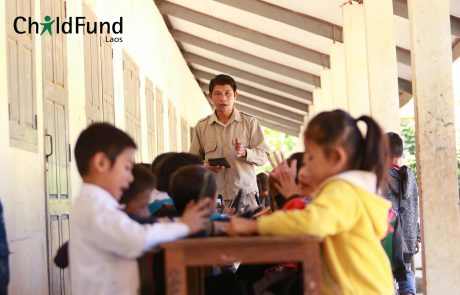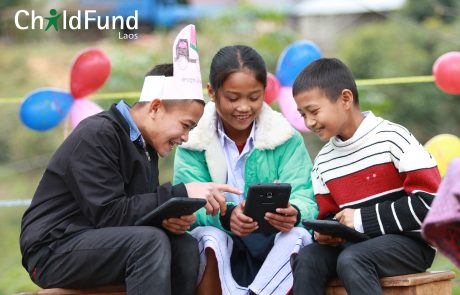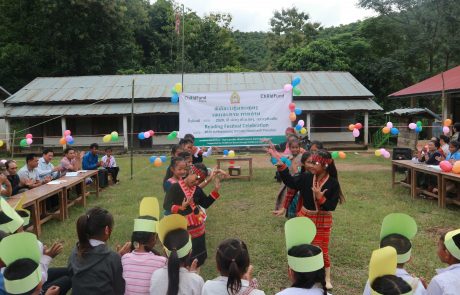Scaling-up Access to Basic Education in Lao PDR (SABEL) in Huameuang District, Houaphanh Province, Lao PDR
Background
Literacy in early grades remains a challenge, with significant differences between urban, rural and remote schools where there are larger numbers of students who do not speak Lao as their first language. Moreover, the causes of poor reading skills among children are influenced by many factors, but the main factor is a lack of any, let alone, age appropriate reading materials in rural and remote area, materials such as newspapers, novels, magazines, and other reading paraphernalia, as well as a lack of opportunities to access reading skills development activities outside formal classes and/or school settings. Teaching capacity remains low and has a compounding effect
Huaphanh is one of the poorest provinces in Lao PDR, with a total population of 296,851 with an underserved population predominant by Hmong, Phong and Khmou ethnic groups. It is a mountainous region with predominately steep terrain. Poverty levels in the province are still high and many people are still living below the official poverty line. Huameuang has a total population of 32,950 ethnically diverse people, compromising 35.75% Phong, 25.62% Khmou and 21.64% Hmong. Approximately 84% of the population do not speak Lao as their mother tongue. Given that, by law, Lao language is the medium of instruction in schools – it is easy to see how this has a direct impact on children’s reading abilities, particularly the more vulnerable. ChildFund has been working in Huameuang since 2016 with the roll out of BEQUAL as well as a ChildFund Korea Early Child Education (ECE) project. During BEQUAL, 32 primary schools were targeted, comprising remote, rural and urban schools, as well as those that that combined and paired grades.
Although recent years have seen a significant improvement in regards to children’s access to and participation in education, there are marked differences not only between Districts, but within Districts – particularly the very remote schools in ethnic communities. Parental income and poverty play a significant role in determining the education outcomes of children. Out of the 76 villages in Huameuang, 46 villages are classified as being poor by the Government of Laos (GoL), compromising 32.25% of poor families (1,693). 72.65% of the population’s livelihood are in the agricultural sector – helping to contribute to a small $682 GDP. A significant portion of these households are ethnic minorities – and this ‘cultural poverty’ often affects girls the most who drop-out early and help their families by working in the fields.
Poor home reading environments, frequent illness and ignorance of formal language instruction have been identified as determinants of poor learning outcomes – particularly in Huaphanh. Inadequate WASH (Water, Sanitation and Hygiene) facilities in schools undermine children’s physical and intellectual development, particularly with time lost in absenteeism due to water-borne illnesses. Schools have the potential to teach and instil new habits among children, who in turn pass on and share key messages and lessons at home. A child’s inability to develop oral Lao language proficiency or basic literacy, despite participation in formal education, is likely to perpetuate poverty.
ChildFund Laos is proposing to target 30 new schools located in Huameuang. Out of the 30 new target schools, 16 are remotelylocated, and 14 are in rural areas. Lessons learnt from BEQUAL have indicated that urban area schools are far more advanced than their less accessible equivalents – hence the rational to target the most remote, and the most needy. To ensure sustainability as well as implement the innovative literacy package and disability inclusion components – SABEL will re-visit the 32 target schools of BEQUAL, 13 of which are remote, 16 rural and 3 urban. In total – SABEL will be working with 62 schools in 62 villages reaching a total of 2,598/1,178F children. In the 32 BEQUAL target schools – there were 5 schools with a total of 14/9Fdisabled children. Data for the 30 new schools is not available on disability and will only be obtained during the baseline.
76% (47 schools) of the targeted 62 are taught in a multi-grade format. There are 35 schools that combine Grades 1 and 2, and 12 schools that combine Grades 1, 2 and 3.
Project Description
Project Goal
Girls and Boys who experience disadvantages complete improved quality basic education
Project Objectives
- Girls and boys improve their learning outcomes in reading and their oral Lao language speaking proficiency
- VEDC, parents and families support inclusion of girls and Children with Disability (CWD);
- 3. Multi-grade guidelines reviewed and better teaching plans Implemented;
- Children adopt improved hygiene practices.
Key Outputs:
- Output 1.1 Lao language and reading promotion delivered to ethnic students
- Output 1.2 Reading corners established and functional
- Output 1.3 Digital Library piloted in 4 schools
- Output 1.4 Extracurricular course delivered to weak learners
- Output 2.1 Training sessions delivered to parents and caregivers
- Output 2.2 Reading Camp volunteers trained
- Output 2.3 Community members provide low-cost reading materials
- Output 2.4 District Forum conducted on participation and inclusion
- Output 2.5 School priorities, particularly inclusion identified and supported by small grants
- Output 2.6 Life skills delivered by Community Instructors (CI)
- Output 3.1 Support contributed to multi-grade guidelines review
- Output 4.1 Hand-washing facilities installed
- Output 4.2 Basic Hygiene training and materials disseminated



